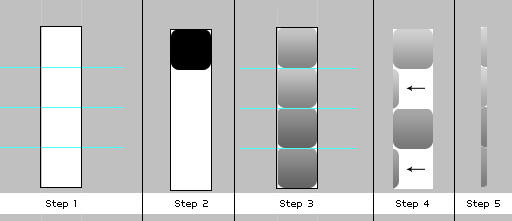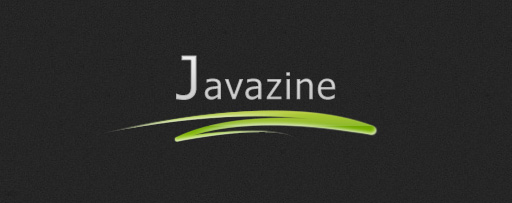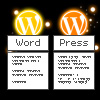
Create an apple style menu and improve it via jQuery
Since I wrote my last tutorial on how to create a CSS only multilevel dropdown menu I got a lot of visitors who wanted to know how I created the main navigation of kriesi.at. (a so called kwicks menu) The interest in extraordinary menus seems to be high nowadays, so today I will teach you how this is done.
Since the Apple-flavored Leopard-text-indent style is currently one of my favorite menu styles, we will start from scratch and build such a menu in Photoshop, then create the needed HTML and CSS and last but not least improve it via jQuery.
This is what we are going to build (don’t forget to hover over the menu)
Since the Tutorial is rather long and comprehensive here is a short overview of the upcoming tasks:
- Part 1: Conceptional Work
- Part 2: Photoshop
- Part 3: HTML and CSS
- Part 4: jQuery
- Part 5: Voluntary Exercise – Rounded Corners
- Part 6: Holy crap, too much work, I just want to download this and leave
Part 1: Conceptional work
First of all you should do some conceptional work since
- you need to know the height of your menu items
- you need to know the width of your menu items, both in normal and hover state.
- you need to know how many items you want
After creating a single JPG file out of photoshop we will use a fairly common technique called CSS Sprites to display the menu. By creating a navigation using an image sprite, you can have a complete navigation with rollovers by only using one image.
Never heard of that technique before? Here is a pretty good explanation if you want to know it in detail
My menu will contain 4 menu items, each 40px high, 125px width in normal state and 200px on hover state.
So I will create a new .psd file with the dimension of 800px x 80px. The width is the result of the hover state multiplied with the number of menu items (200 x 4), the height is two times the menu height: we will display the hover state of the menu item directly below the normal state.
Part 2: Photoshop
After creation of your new photoshop file you should add some layer guides. This really helps aligning the different menu items pixel perfect:
 As you can see i divided the canvas with a single horizontal line at the 40px mark, and made a guide every 200px to mark the end of each menu item. I then made a guide for the 125px normal state as well. These Guides are not needed but very helpful ;)
As you can see i divided the canvas with a single horizontal line at the 40px mark, and made a guide every 200px to mark the end of each menu item. I then made a guide for the 125px normal state as well. These Guides are not needed but very helpful ;)
![]() Now create a new layer, select black (this is important for later) as foreground color and draw a rectangle which fills the upper half of your file. Then double click the layer in the Layers palette to open the layer styles, select Gradient and apply a gradient with the foreground color #959595 and #d0d0d0 as your background color. The result should look similar to the the picture above. Opacity should be 100%.
Now create a new layer, select black (this is important for later) as foreground color and draw a rectangle which fills the upper half of your file. Then double click the layer in the Layers palette to open the layer styles, select Gradient and apply a gradient with the foreground color #959595 and #d0d0d0 as your background color. The result should look similar to the the picture above. Opacity should be 100%.
 Now we are adding the inset text: Select the Type tool and set the font to Myriad Pro Regular and #444444 as color. Open the layer styles for this layer and select the Drop Shadow option, then apply the following settings:
Now we are adding the inset text: Select the Type tool and set the font to Myriad Pro Regular and #444444 as color. Open the layer styles for this layer and select the Drop Shadow option, then apply the following settings:
- Blend Mode: Normal
- Color: #FFFFFF (white)
- Opacity: 50%
- Use global light: off
- Angle:90°
- Distance:1
- Spread: 0
- Size:0

To center the text pixel perfect horizontally as well as vertically select the marquee tool and draw a rectangle. Thanks to the layer guides the rectangle will snap into position and have the exact same height and width for each item. Then select the move tool and hit the align buttons for align vertically and horizontally. Repeat this for each menu item.
![]() Next we will add the icons for the hover effect. I used the famous “Bright” Icon set by Min Tran. These icons should be applied between the 125px and 200px guide. After doing that create a new folder in the layer palette and put all layers created until now into this folder.
Next we will add the icons for the hover effect. I used the famous “Bright” Icon set by Min Tran. These icons should be applied between the 125px and 200px guide. After doing that create a new folder in the layer palette and put all layers created until now into this folder.
![]() Now duplicate this folder. Select it with the Move tool and drag it 40pixel down. The horizontal guide should help you putting it into the right place. After doing that go to the layer style palette for this layer and set the opacity of the gradient to 80%. Last thing to do is to change the color of the Text to #FFFFFF and edit the Text layer styles:
Now duplicate this folder. Select it with the Move tool and drag it 40pixel down. The horizontal guide should help you putting it into the right place. After doing that go to the layer style palette for this layer and set the opacity of the gradient to 80%. Last thing to do is to change the color of the Text to #FFFFFF and edit the Text layer styles:
Set the drop shadow to -90° and the color to #000000. The image above shows you how your image should look now.
 To add the borders between the menu points select the line drawing tool and set the foreground color to #969696. Select the pixel mode and remove the checkmark from anti alias. This is needed to draw a exact line of 1px without any blur. After drawing this line from top to bottom of the image go to the layer style palette again and add a border of 1px, color: #b8b8b8, position outside and set the Blend Mode to Lighten.
To add the borders between the menu points select the line drawing tool and set the foreground color to #969696. Select the pixel mode and remove the checkmark from anti alias. This is needed to draw a exact line of 1px without any blur. After drawing this line from top to bottom of the image go to the layer style palette again and add a border of 1px, color: #b8b8b8, position outside and set the Blend Mode to Lighten.
After doing that align the borders directly beside the layer guides as seen in the picture.
What we got now should look something like this:
Now export this image as kwicks_sprite.jpg. Don’t slice anything, just export the picture ;)
Part 3: HTML and CSS
The HTML part is rather easy: all we need is an unordered list with classname kwicks. Each list item must have an id which is composed of kwick + the number of the item.
<ul class="kwicks">
<li id="kwick1"><a href="#">Home</a></li>
<li id="kwick2"><a href="#">Contact</a></li>
<li id="kwick3"><a href="#">Downloads</a></li>
<li id="kwick4"><a href="#">Search</a></li>
</ul>
Thats it for the HTML part, now comes the CSS:
.kwicks {
list-style-type: none;
list-style-position:outside;
position: relative;
margin: 0;
padding: 0;
}
This is needed to remove margins and paddings from the menu, as well as the list bullets.
.kwicks li{
display: block;
overflow: hidden;
padding: 0;
cursor: pointer;
float: left;
 width: 125px;
 height: 40px;
 margin-right: 0px;
 background-image:url(kwicks_sprite.jpg);
 background-repeat:no-repeat;
}
Major styling done for the list item here. Height and width are set and our image is set as background for each list item. Since we don’t want to display the normal list Text we set the text indent for all links to:-9999px:
.kwicks a{
display:block;
height:40px;
text-indent:-9999px;
outline:none;
}
What we got now looks pretty good: HTML- Step 1
Now we want to display the appropriate menu point so we have to change the offset of the background image with css for each list item:
#kwick1 {
background-position:0px 0px;
}
#kwick2 {
background-position:-200px 0px;
}
#kwick3 {
background-position:-400px 0px;
}
#kwick4 {
background-position:-600px 0px;
}
And voila, looks like a real menu: HTML- Step2
Next thing we do is adding the roll over state:
#kwick1.active, #kwick1:hover {
background-position: 0 bottom;
}
#kwick2.active, #kwick2:hover{
background-position: -200px bottom;
}
#kwick3.active, #kwick3:hover {
background-position: -400px bottom;
}
#kwick4.active, #kwick4:hover {
background-position: -600px bottom;
}
The pseudo class “:hover” is added to the list item and not to the <a> tag. Since Internet Explorer 6 can only work with this pseudo class when applied to an <a> tag we define an extra active class which accomplishes the same. This class will be automatically added by the jQuery script on hovering. You might ask yourself why I didn’t style the <a> tag with the background image to circumvent this problem. I do this because of the round corners which I will apply later on. I could have done it anyway with a little bit of extra HTML markup but I want to keep the HTML as clean as possible. It’s truly only a matter of preference. If you intend to create a menu without round corners you can apply the background images, as well as the offsets directly to the <a> tag.
So if you are using a browser other than IE6 you can see a basic CSS sprite menu with different hover states now: HTML- Step3
Thats it for the CSS part, we will add the round corners add the end of the tutorial since its something not everyone will be interessted in and demands a little bit of extra work.
Part 4: jQuery
To add the sliding effect we need to add the wonderful kwicks plugin for jQuery created by Jeremy Martin. Of course you need to import the jQuery framework as well.
Your HTML head should look something like this:
<link rel="stylesheet" href="style.css" type="text/css" media="screen" /> <script type='text/javascript' src='jquery-1.2.6.min.js'></script> <script type='text/javascript' src='kwicks.js'></script> <script type='text/javascript' src='custom.js'></script>
Be careful with the order of the items. Due to the fact that the kwicks plugin relies on some of the CSS classes we defined you must include the CSS before the kwicks.js file. The custom.js file is a blank Javascript file which you should create, we will now add the code of execution to this file:
function my_kwicks(){
$('.kwicks').kwicks({
duration: 300,
max: 200,
spacing: 0
});
}
$(document).ready(function(){
my_kwicks();
});
The code is rather easy to understand: the function my_kwicks calls the execution of the plugin with several parameters:
- duration of the sliding effect in milliseconds
- max width of each kwicks item in pixel
- spacing between the items in pixel
You can define many more parameters, a comprehensive list can be found at the plugin page at the documentation tab.
The ready function executes the code as soon as the site (in particular the DOM) is loaded. Thats it for the jQuery magic as well: here we got the working example
Congratulations, you are done now ;)
Part 5: Voluntary Exercise – Rounded corners
The rounded corners can be added with different techniques. Since a major part of this tutorial is dedicated to the task of CSS Images sprites we will extend this a little bit by creating a rounded corner sprite. One image for the left and right corners, along with the hover state. The easiest way creating an image sprite like this is aligning the different sprites below each other. Since we need 4 different sprites we will create an image of 160px height and a width of your choice. The width doesn’t matter since we will crop the image afterwards. ( I will use 40px width for now)
- First you should add layer guides again for pixel perfect alignment.
- Select black as your foreground color and draw a rounded rectangle (8px radius, anti alias:on).
- Copy this rectangle 4 times and apply the same layer style of the menu background, which we created in Part 2: Photoshop. The 2 bottom rectangles are for the hover state of the menu, so they need to have the same layer style as the hover state of the menu items (opacity:80%)
- Now move rectangle 2 and 4 out of the canvas until you only see the round corners.
- Crop the image so that only the round corners can be seen.
 Export the Image as end.jpg and add the following styles to your CSS file:
Export the Image as end.jpg and add the following styles to your CSS file:
#kwick1 a{
background-image:url(end.jpg);
background-repeat:no-repeat;
background-position: left 0px;
}
#kwick1 a:hover{
background-position: left -80px;
}
#kwick4 a{
background-image:url(end.jpg);
background-repeat:no-repeat;
background-position: right -40px;
}
#kwick4 a:hover{
background-position: right -120px;
}
This adds the corner sprite to the first and fourth menu item and overalps the background for the list item.
Your are done now: here is the final menu
Part 6: Holy crap, too much work, I just want to download this and leave
Well, in case you couldn’t get this to work or are to lazy to create the files: here is a Zip- Package with all items: psd files, html, css and javascript:
Includes: PSD Files, HTML File, CSS File, Javscript Files
Hope you liked the tutorial and learned something, have a nice day ;)









that’s great i am waiting for its thanks.
I’d just like to tell you how much I learnt from your blogs Bookmarked u.Hope 2 be back in the near future for some more good stuff
http://health-online.tressugar.com/Online-Aciphex-11512749
Hi,
I have a problem. I’m making my own custom WP theme (my first ever) and i thought i’ll use this as my menu. But i just can’t seem to make it appear properly. What do i need to do? Where EXACTLY should i put all the files i downloaded? I just put everything in my theme’s folder and images in another folder called ‘images’ but this is not working. Please help!
Thanks :)
I don’t really like this tutorial. I’m on your blog for a while and I know you can design very well, but this made me dissapointed.
Worked great, thank you. Had no problems, other than your javascript did not work, had to adjust your javascript to the following:
$().ready(function () {
$(‘.kwicks’).kwicks({
duration:300,
max: 140,
spacing: -2
});
});
Thanks.
Thanks
i like this effect :* :* :*
Absolutely love it thanks!
Can anyone help me, same as Rusty mentioned, I want a button to remain pressed down when the linked page opens?
all best
Окна Уфа, Пластиковые окна Уфа
nice menu :)
great for mac lover…. thx
Hey, thankz for this wonderful tutorial which I really do admire, but can anyone here please and kindly help me out by converting the menu to a drop down menu?Thanks…
Your ability to gather thoughts in a logical order is less than desirable. Thanks for trying.
Ремонт компьютеров в Уфе, ремонт ноутбуков в Уфе
so what if I was designing arabic navigation menu, how can I import starting from right side?
background-position:-200px 0px; <<this imports it from the left side
I have tried this
background-position:100% 0px; <<< it worked but its not so precise
anyone knows?
I very discover this a eyeopener. In no way looked at it in this way. If you are heading to write some additional postings about this subject, I definitely will be back soon! Btw your layout is extremely briliant. I’ll be utilizing one thing similar for my own blog if it’s ok with you.